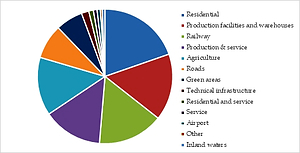Current issue
Online first
Archive
About the Journal
Aims and scope
Editorial Board
International Editorial Board
List of Reviewers
Abstracting and indexing
Ethical standards and procedures
REMV in Social Media
Contact
Instructions for Authors
Instructions for Authors
Manuscript formatting template
Title page
Highlights
Payments
‘Ghostwriting’ and ‘Guestauthorship’
Guidelines for Referees
Spatial Chaos in the Airport-Proximate Areas - Case Study of Gdansk Lech Walesa Airport
1
Departament of Investment and Real Estate, University of Gdańsk, Poland
Submission date: 2022-03-31
Final revision date: 2022-06-09
Acceptance date: 2022-06-30
Publication date: 2022-12-09
REMV; 2022;30(4):55-73
HIGHLIGHTS
- the airport is an opportunity for the development of the proximate areas but also a source of conflicts
- coherent vision of the development and spatial management is a necessary condition for spatial order
- spatial chaos is a global and recognized problem, but it is not homogeneous in Europe
- cities have spatial chaos-related problems clearly connected with spatial planning and urban sprawl
KEYWORDS
TOPICS
ABSTRACT
The airport may be an opportunity for the development of airport-proximate areas, as well as a source of conflicts and nuisances for stakeholders. From the perspective of spatial order and sustainable development, it is necessary to create a coherent vision of the development and operationalize it via spatial management. This article aims to analyze spatial management in areas proximate to Gdansk Airport in the context of spatial chaos. The analyses are based on 232 local spatial development plans for the period 1996-2020, for 11 selected areas in the vicinity of the Gdansk Lech Walesa Airport, documents obtained from the local government, and open-source data. The research concentrates on the analysis of the functions of areas, spatial chaos, and the threat of potential conflicts. The results demonstrate the spatial chaos in proximate areas of Gdansk Airport. This implies that the decisions made by the authorities responsible for spatial management do not respect spatial order and sustainable development and contribute to spatial chaos.
Share
RELATED ARTICLE
We process personal data collected when visiting the website. The function of obtaining information about users and their behavior is carried out by voluntarily entered information in forms and saving cookies in end devices. Data, including cookies, are used to provide services, improve the user experience and to analyze the traffic in accordance with the Privacy policy. Data are also collected and processed by Google Analytics tool (more).
You can change cookies settings in your browser. Restricted use of cookies in the browser configuration may affect some functionalities of the website.
You can change cookies settings in your browser. Restricted use of cookies in the browser configuration may affect some functionalities of the website.




